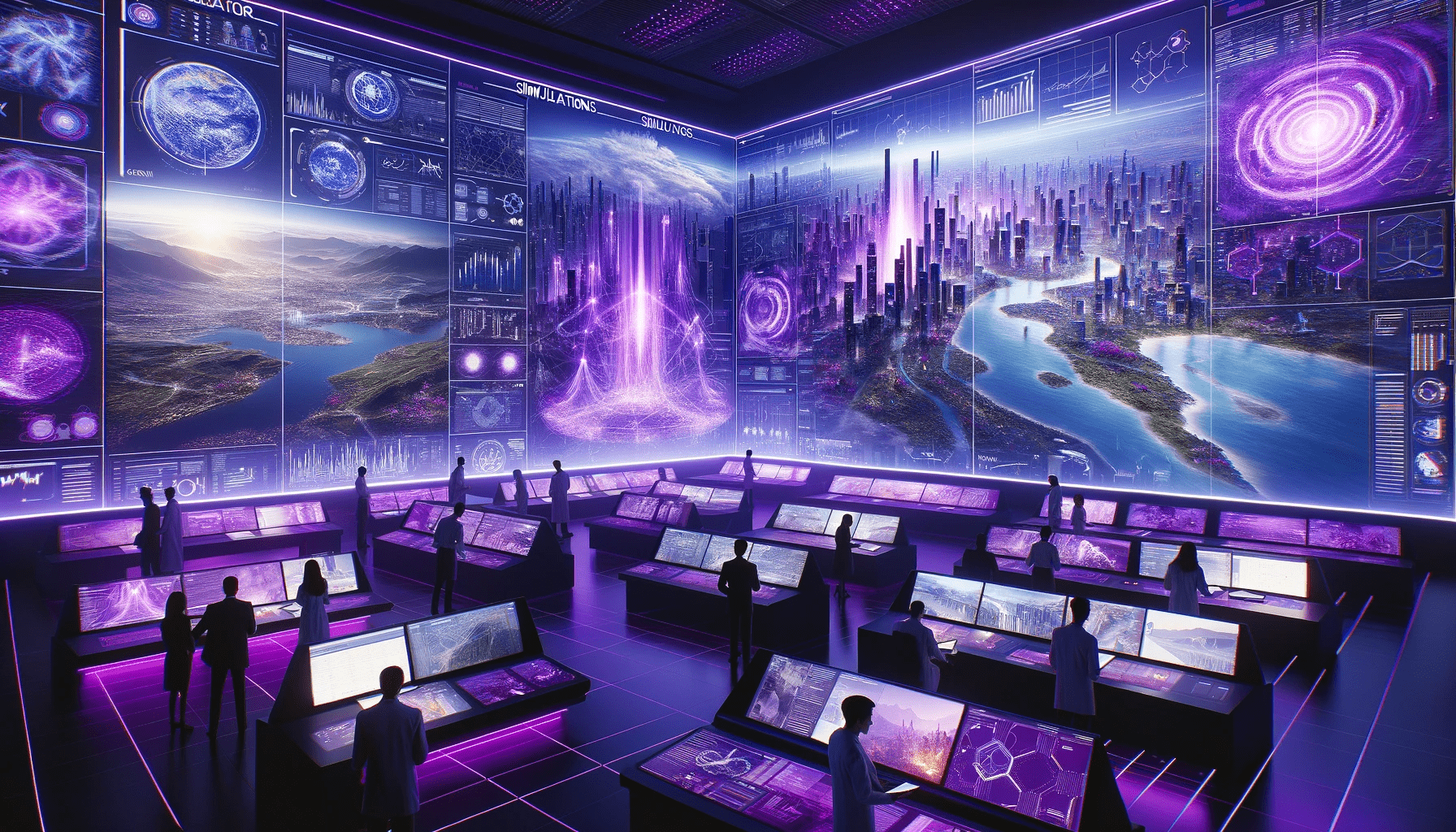During iluminr Strategy Week 2024, we dedicated a significant portion of our time to future-gazing – a forward-looking exercise where we explored the potential and possibilities of scenario testing and simulation in our strategic planning. This exercise was not just about theorizing; it was an active engagement with emerging trends and technologies.
We tested various future scenarios, simulating different hypotheticals to assess and improve our response strategies, taking on the roles of varied players in our operating ecosystem. The outcomes of these sessions were illuminating, revealing both challenges and opportunities that we might face in the near future.
The world of scenario testing, simulations and tabletop exercises is undergoing a remarkable transformation. As technology continues to advance, teams building their team’s response capability through more immersive, realistic, and versatile experiences.
As we open 2024, we’re sharing 6 key trends shaping the landscape of scenario testing, simulations and tabletop exercises.
Trend 1: Interactivity
One of the most prominent trends in the field of simulations and tabletop exercises is the heightened emphasis on interactivity. This shift represents a departure from traditional, static exercises toward more dynamic and responsive simulations. Participants are no longer passive observers but active contributors to the scenarios they encounter.
Interactivity encourages collaborative problem-solving and decision-making, fostering team cohesion and critical thinking skills. Participants are challenged to adapt and respond in real-time, allowing them to identify strengths and weaknesses in their strategies and communication protocols. Feedback and debriefing sessions following these exercises are essential for extracting valuable insights and refining response plans, making them more robust and adaptable in the face of evolving threats.
Teams are creating these interactive learning experiences with a combination of out-of-the-box scenarios, purpose-built, intuitive workflows, and bespoke elements designed to the unique needs of their operating environment, eliminating the need for complex configuration and time-intensive production.
Trend 2: Enhanced Realism
More organizations are crafting realistic scenarios that closely emulate potential real-world situations. Research suggests that the more authentic and immersive the exercise, the better it prepares participants for actual events. To achieve this level of realism, scenario planners are delving into the intricacies of their organizations, industries, even their operating ecosystem to create simulations that are both relevant and engaging.
One key strategy in achieving this realism is the extensive use of multimedia elements. These exercises leverage a variety of multimedia resources, including video, audio, and interactive visualizations, to bring scenarios to life. By incorporating multimedia, teams can replicate the sensory aspects of real incidents, immersing participants in a dynamic and multi-dimensional environment. For instance, a cybersecurity tabletop exercise might include simulated hacker intrusion attempts with realistic sound effects and visual representations, providing a more authentic experience for IT teams.
These exercises are designed to draw upon the same people, places, processes, systems, data, and third-party entities that would be involved in a live event. By developing exercises that closely mirror their operational environment, organizations can assess their readiness more accurately and identify areas for improvement.
Immersive and authentic scenarios not only enhance the effectiveness of the exercises but also provide a valuable opportunity for teams to refine their incident response strategies, communication protocols, and coordination with external stakeholders.
Trend 3: Integration of Emerging Tech
The integration of emerging technologies represents a pivotal and transformative trend in the realm of scenario testing, tabletop exercises and simulations. One of the most significant advancements in this area is the prominent role played by artificial intelligence (AI).
AI is now at the forefront of simulation design, making it easier and more efficient than ever to create effective scenarios. It was just a year ago we collaborated with the community on practical ways they were already using technology such as ChatGPT. These use cases have only expanded as the data and the technology have improved.
In the future, integrated AI enhance the overall experience by creating dynamic scenarios and adaptive responses based on participants’ actions. AI-driven systems can adjust parameters, introduce unexpected events, or modify scenarios in real-time, challenging participants to think on their feet and adapt to evolving situations.
AI-driven virtual opponents and teammates will become a valuable addition to simulations, providing asynchronous learning in a multi-player environment, even outside of the team context. These intelligent virtual agents will mimic human behavior, providing participants with realistic interactions and responses. Virtual teammates can assist and collaborate with participants, while virtual opponents can pose challenges and unpredictabilities, adding an extra layer of complexity to the exercises.
AI agents have the ability to represent other stakeholders even when those individuals are not physically present. This capability is particularly significant in the context of swarm intelligence, where multiple agents collaborate to solve complex problems or make decisions collectively. AI agents can emulate the perspectives, preferences, and decision-making criteria of absent stakeholders, effectively extending their presence into the decision-making process. By doing so, these AI agents contribute to a more comprehensive and diverse pool of inputs, enriching the collective intelligence of the swarm. This not only enhances the overall decision-making quality but also enables organizations to harness the wisdom and expertise of a broader range of stakeholders, regardless of geographical or logistical constraints. As a result, AI-driven swarm intelligence becomes a powerful tool for tackling multifaceted challenges and fostering inclusive decision-making processes that transcend physical boundaries.
Both now and in the future, the integration of these emerging technologies not only enhances the realism and effectiveness of tabletop exercises and simulations but also prepares participants to deal with the complexities and challenges posed by these technologies in their actual environments. In addition, the data generated during these exercises can be analyzed to identify trends, performance gaps, and areas for improvement, contributing to the cycle of continuous learning and informed decision-making.
Trend 4: Enterprise Scale
No longer confined to the exclusive domain of risk, resilience, crisis and incident management teams, scenario testing, tabletops and simulations have undergone a process of democratization, extending their reach and impact across the entire enterprise. This transformation underscores organizations’ deep recognition of the profound impact scenario testing and simulations can have on risk mitigation and the fostering of resilience at all levels.
One of the remarkable developments is the widespread integration of simulations into various aspects of risk management and resilience building. Sales and customer service teams are harnessing simulations to enhance their ability to adapt to unforeseen challenges, manage customer expectations, and maintain business continuity in times of disruption. By immersing themselves in simulated scenarios, employees can develop the skills needed to navigate volatile markets and customer demands, ultimately contributing to the organization’s resilience in the face of economic uncertainty. Board and executive leadership development programs have also embraced simulations as a means to prepare leaders for navigating complex risk landscapes. Through simulated risk scenarios, both aspiring and seasoned leaders can refine their decision-making, crisis response, and strategic planning abilities. This immersive learning approach equips leaders to make informed choices in high-stakes situations, strengthening the organization’s ability to proactively manage and mitigate risks.
One of the most obvious ways tabletops and simulations are being leveraged is in the context of cybersecurity. Information security and cybersecurity teams are increasingly relying on simulations to prepare for cyber threats and network vulnerabilities. By engaging in realistic cybersecurity exercises, teams can enhance their capacity to detect, respond to, and recover from cyberattacks effectively. This proactive approach not only bolsters the organization’s cybersecurity resilience but also minimizes potential disruptions and data breaches.
The democratization of simulation-based learning ensures that employees across all departments and roles can actively contribute to risk management and resilience efforts. By equipping a diverse array of personnel with hands-on experience in risk scenarios – from the front line to the boardroom – organizations foster a culture of risk-awareness and collaboration. Cross-functional teams collaborate within these simulations to address multifaceted risks, promoting a holistic understanding of potential threats and strengthening the organization’s overall resilience.
Trend 5: Right-Sized
There is increasing recognition of the role of different lengths, modalities, and formats in the design of tabletop exercises and simulations.
Microsimulations, short, bite-sized scenarios delivered through gameplay, can be instrumental in pinpointing strategic considerations within the realm of risk and resilience. By immersing participants in these targeted scenarios, organizations can scrutinize their strategic responses, isolate vulnerabilities, and assess the effectiveness of their high-level decision-making processes. This strategic reconnaissance enables organizations to fine-tune their overarching risk management strategies, adapting to emerging threats and challenges.
Seen as complementary more than mutually exclusive, there is a symbiotic relationship between Microsimulations and tabletop exercises. Where Microsimulations function as strategic scouts, identifying key areas of concern, tabletop exercises serve as the ground for detailed exploration and refinement. This dynamic interplay ensures that organizations are well-prepared to face a wide array of risks and challenges, with a precise understanding of strategic considerations and a comprehensive grasp of the tactical aspects needed to effectively manage and mitigate these risks. By strategically integrating Microsimulations and tabletop exercises into their training and preparedness programs, organizations are enhancing their adaptability and resilience in an ever-changing risk landscape.
Gamification elements further enhance the adaptability of training experiences. By incorporating game-like features such as scoring, competition, and rewards, organizations can make simulations and exercises more engaging and immersive. These elements motivate participants to actively engage with the training material and apply their knowledge effectively. Gamification also allows for individualized experiences, catering to different learning styles and preferences within an organization.
Organizations are embracing a flexible, customized approach that combines varying lengths, single- versus multi-player formats, and gamification elements to create tailored learning experiences. This adaptive strategy ensures that organizations can address their unique challenges, time constraints, and skill development needs effectively. By offering a spectrum of training options, organizations empower themselves to navigate the complexities of risk management with precision and agility in an ever-evolving landscape.
Trend 6: Continuous Learning
Continuous learning in tabletop exercises and simulations has gained significant traction in recent years as organizations recognize the importance of being prepared for various scenarios and challenges. This shift reflects a broader understanding that learning and improvement should not end with the conclusion of a single exercise. Instead, organizations are increasingly adopting a cyclical approach, which involves using the valuable insights gained from each simulation to refine their strategies, enhance their processes, and train their personnel more effectively.
One key aspect of this iterative process is the comprehensive analysis of the simulation’s outcomes. After each exercise, teams gather to review their performance, identifying both strengths and weaknesses. By closely examining what went well and what didn’t, organizations can pinpoint areas in need of improvement and make necessary adjustments. This process allows for the development of more robust strategies, the optimization of existing procedures, and the fine-tuning of skills.
Continuous learning through tabletop exercises and simulations nurtures a culture of adaptability within organizations. It encourages a mindset where teams embrace change and are willing to challenge the status quo. In such an environment, teams become more agile and better equipped to respond to evolving challenges in an ever-changing world.
Another critical element of this approach is the real-time application of lessons learned. As organizations accumulate knowledge and experience through multiple simulations, they can immediately apply these insights to their day-to-day operations. This proactive approach ensures that the benefits of continuous learning are not confined to hypothetical scenarios but are integrated into the organization’s core practices, making it more resilient and better prepared for unexpected events.
This iterative process fosters collaboration and communication within teams. As individuals work together in tabletop exercises and simulations, they build trust and strengthen their ability to coordinate effectively. This extends beyond the exercises themselves and enhances teamwork in other aspects of the organization.
The adoption of continuous learning through tabletop exercises and simulations is a strategic imperative for modern organizations. It empowers them to harness the power of experience, data, and innovation to refine their strategies, optimize their processes, and enhance their team’s capabilities. This approach not only prepares them for a wide range of challenges but also cultivates a culture of adaptability and resilience, ensuring that they stay ahead in an ever-evolving world.

Image: DALL·E futuristic visualization of simulations
The Tabletops of Tomorrow
Today, we are witnessing the seeds of tomorrow’s tabletops being sown. Advancements in technology are already driving the development of more immersive and realistic simulations. Organizations are increasingly tailoring training programs to meet specific needs and integrating elements of emerging technology, such as AI, into their exercises. The democratization of training is also on the rise, with a growing recognition of the importance of involving various departments and employees in preparedness efforts. The emphasis on continuous learning and iterative improvement today is laying the groundwork for tomorrow’s even more advanced tabletop exercises, where the insights gained from today’s simulations will shape the strategies and readiness of the future.
These evolving trends are already shaping the landscape of experiential learning and enhancing organizations’ adaptability and resilience.
Interested in learning more about iluminr’s tabletops of tomorrow? Stay tuned for more information about our January Product Roadmap webinar.
Author
Paula Fontana
VP, Global Marketing
iluminr















